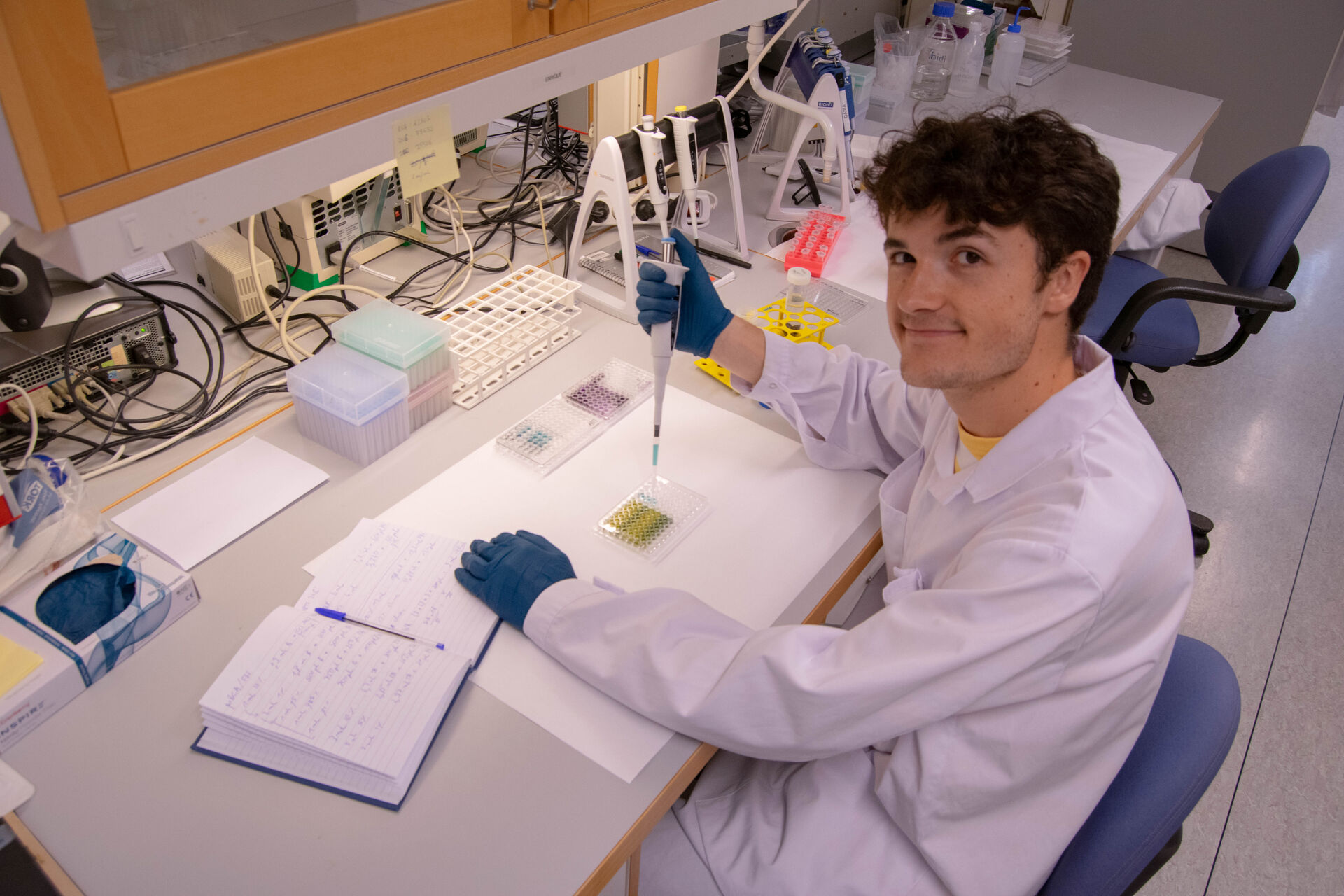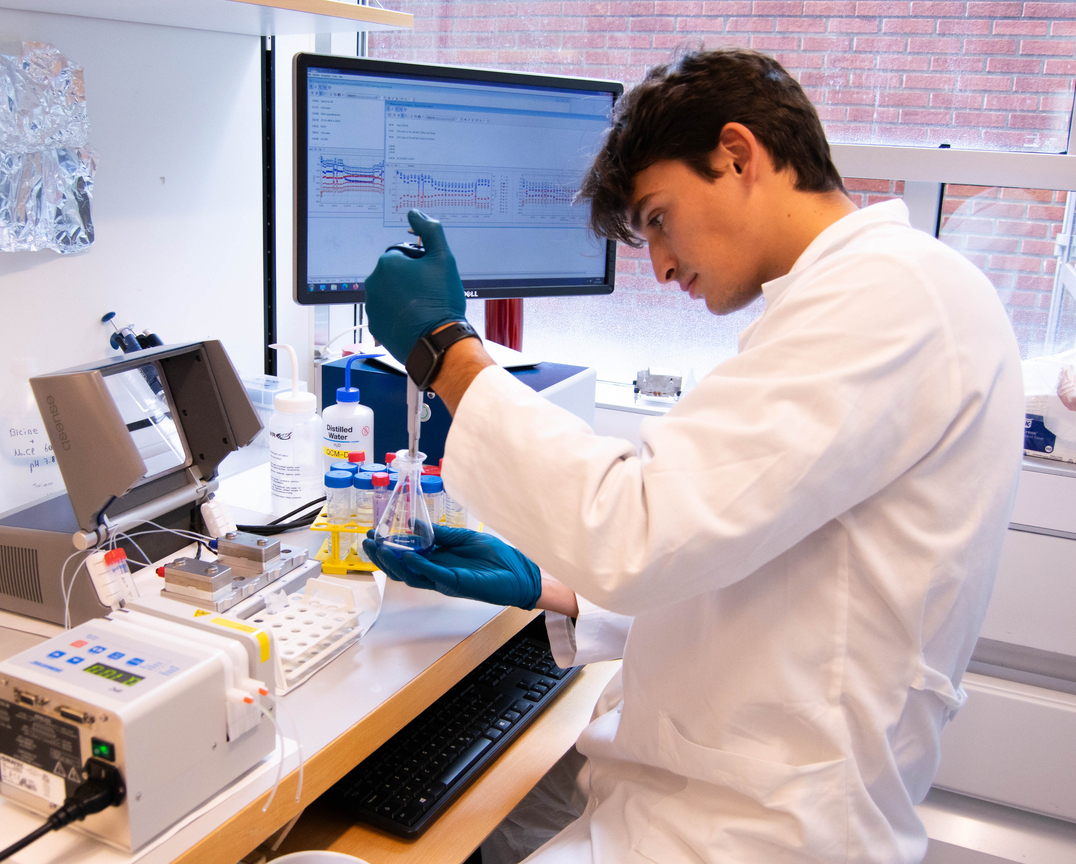
Meet our summer interns Léa, Killian and Enzo
This summer, the Department of Biomaterials was hosting three materials engineering students from Polytech Nantes: Léa Lecomte, Killian Robion and Enzo Galli. We at the lab were very glad to have new students bringing a bit of extra life to the otherwise quiet summer months, but let's hear from our students how they experienced their time in Oslo.
Léa: I am an engineering student at Polytech Nantes in the field of materials. During my studies in Nantes, I had the chance to spend five months as a research intern at Department of Biomaterials in Oslo. In my studies, I focus more on metallurgy and welding, but the internship introduced me to a very different aspect of materials science and how materials can be used in healthcare applications.
Killian: Like Léa, I study materials engineering at Polytech Nantes, which is part of the biggest engineering school networks in France. As part of the training for students studying in the engineering programmes within this network, we all do an internship abroad after our fourth year, which is bit of a French speciality. I had the opportunity to do my 3-month internship at the Department of Biomaterials last summer, which gave me a chance to work on something new. In my four years of studying materials engineering, I have been introduced to different types of materials and their application in various different fields such as welding or batteries, but biomaterials and nanocoatings was something I was not familiar with before coming to Oslo. One of the reason why I chose to work with dental biomaterials was also because I really want to work in the medical field in the future, as this would allow me to work with something that is useful and beneficial for the society in a very concrete way.
Enzo: I also finished my 4th year of materials engineering studies this spring. Since I was about to start a double degree programme in biomaterials and medical devices, I wanted to do an internship that is related to this field. I heard about an opportunity to do a research internship at the Department of Biomaterials in Oslo through a former student at my university who had previously done his internship at the same lab. I was glad to have been offered an opportunity to work in a research project focusing of surface properties of dental crowns made of zirconia.
What have they learned during their stay in Oslo?
Léa: During my internship, I produced calcium carbonate nanoparticles and evaluated their stability in the presence of water over time. If the particles are not chemically stabilised by for example adsorbing organic molecules on their surface, the synthesised particles will transform from vaterite crystals to more stable calcite crystals when the particles are in contact with water. With the method I used in my internship, we managed to stabilise the vaterite CaCO3 particles for over two months in water. I used these stabilised nanoparticles to produce emulsions of oil microdroplets that can be used to deliver capsaicin to oral mucosa using Pickering emulsion technique.
This project allowed me to learn how to use many different characterisation methods to determine the stability of CaCO3 nanoparticles and the oil-in-water emulsions I was making using the particles. By coming to Oslo, I gained a lot of new knowledge about biomaterials and how they are tested before they can be used in patients. I was also able to strengthen my language skills working in a very international research group and met some very good people who helped me evolve both as a scientist and as the person I am.
Killian: In my research project, I worked together with Enrique Oreja to study the chemical properties of tannic acid-coated dental implant surfaces. I determined the release of tannic acid molecules from nanocoatings deposited on titanium surfaces and their capacity to scavenge free radicals. I also learned how to use quartz crystal microbalance to follow adsorption and desorption of blood proteins, such as albumin and fibrinogen, on the coating surface in real time, and tried to characterise their binding onto the surface with UV-vis and infrared spectroscopy.
Overall, the internship was a very enriching experience for me as I learned a lot of characterisation techniques. But most of all, I learned that research experiments do not always give you the answers you wanted to get, and sometimes, experiments need to be repeated. Being a scientist is not just about going to the lab and running an experiment, but we also need to discuss the results we got, find alternative ways to the do the experiments that failed, and then do the experiment again but better. This really taught me to be more patient, work more meticulously, and it built up my resilience. But I was also surprised how easy it was to interact with people I was working with and how willing everyone was to help each other in the lab.
In addition to wanting to learn what it is like to work in a scientific research lab, I came to Oslo to discover the Norwegian way of life that a lot of people in France view as the ideal life. I have a cousin who has lived in Stavanger for a few years and I have heard many stories about Norway, so I had to come and see all it for myself. Compared to France, Norway seems more advanced in terms of mentality and use of technology, and when you combine that with all the nature with a lot of forests, mountains and hiking spots, it is a very nice country to live in. Well, I think I was very lucky that the internship was during the summer, though. I suppose life in Norway is very different in the winter... While I was staying in Oslo, I shared an apartment with Enzo so it was really nice to share my Norwegian experience with him.

Enzo: My internship project focused on comparing the efficacy of different cleaning methods to remove adsorbed contaminants from zirconia surfaces and their impact on adhesion of molecules called 10-MDP that are used to improve the attachment of dental crowns to resin cement used to fix the crowns onto teeth. For this purpose, I contaminated zirconia surfaces with saliva and observed the detachment of the adsorbed salivary pellicle from the surface and subsequent attachment of 10-MDP molecules after applying different chemical cleaning agents using a quartz crystal microbalance, which was a technique I had never used before. I was also able to characterise the morphology and chemical composition of the used zirconia crown materials using electron microscopy and determined the surface energy of the zirconia surfaces before and after the cleaning procedures. This project was a great opportunity for me to broaden my knowledge in materials science and learn new characterisation techniques, and also to discover the surprisingly interesting world of research in dental materials.

Everyone at the Department of Biomaterials welcomed me warmly and I felt myself at ease from the very first day at the lab. I have even kept in touch with some of the other students who were doing their internships lab after I left Oslo. The nice thing about the biomaterials lab is that they welcome internship and PhD students from all over to world, which makes it very easy to blend in and learn about other cultures. I also had a chance to improve the level of my English during many interesting conversation I had at the lab.
I would especially like to thank my supervisors Hanna and Alejandro for always being available to help me understand all the different aspects of my project, whether it was about how the different instruments worked or how the dental crowns were made or attached to teeth.

